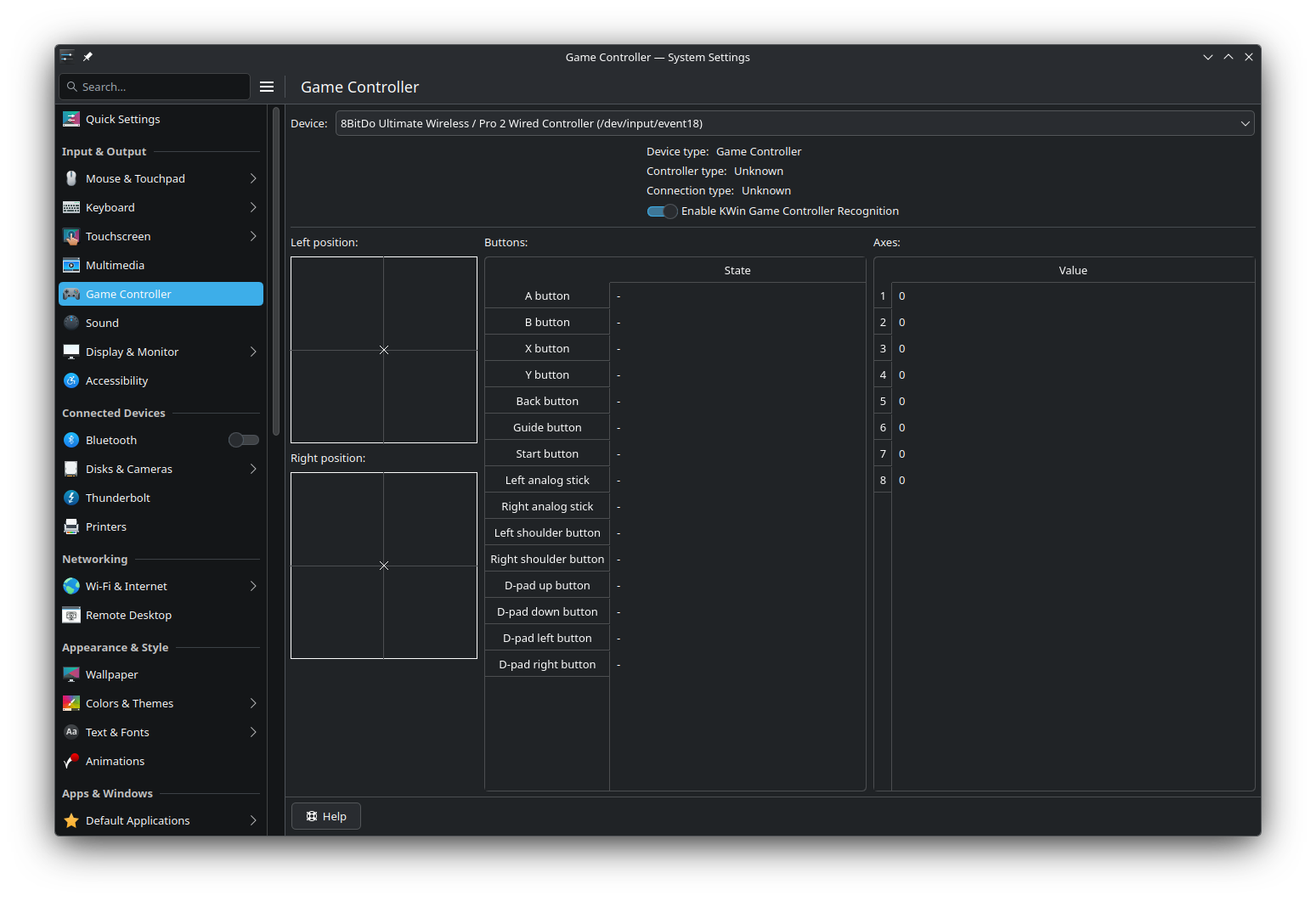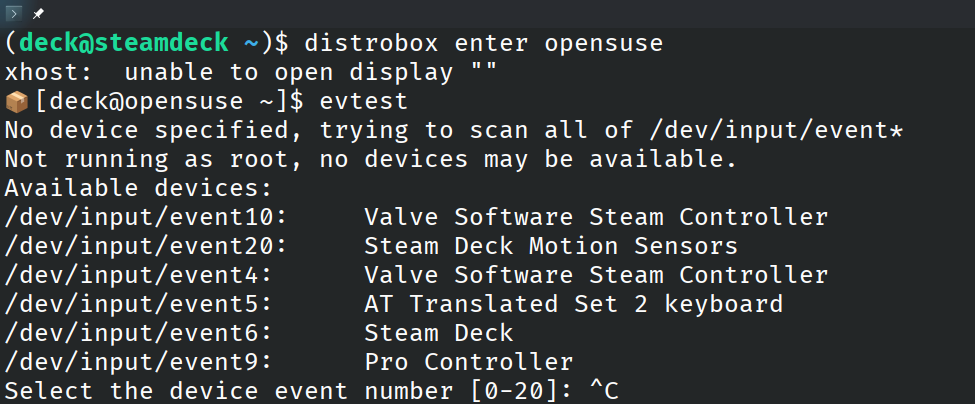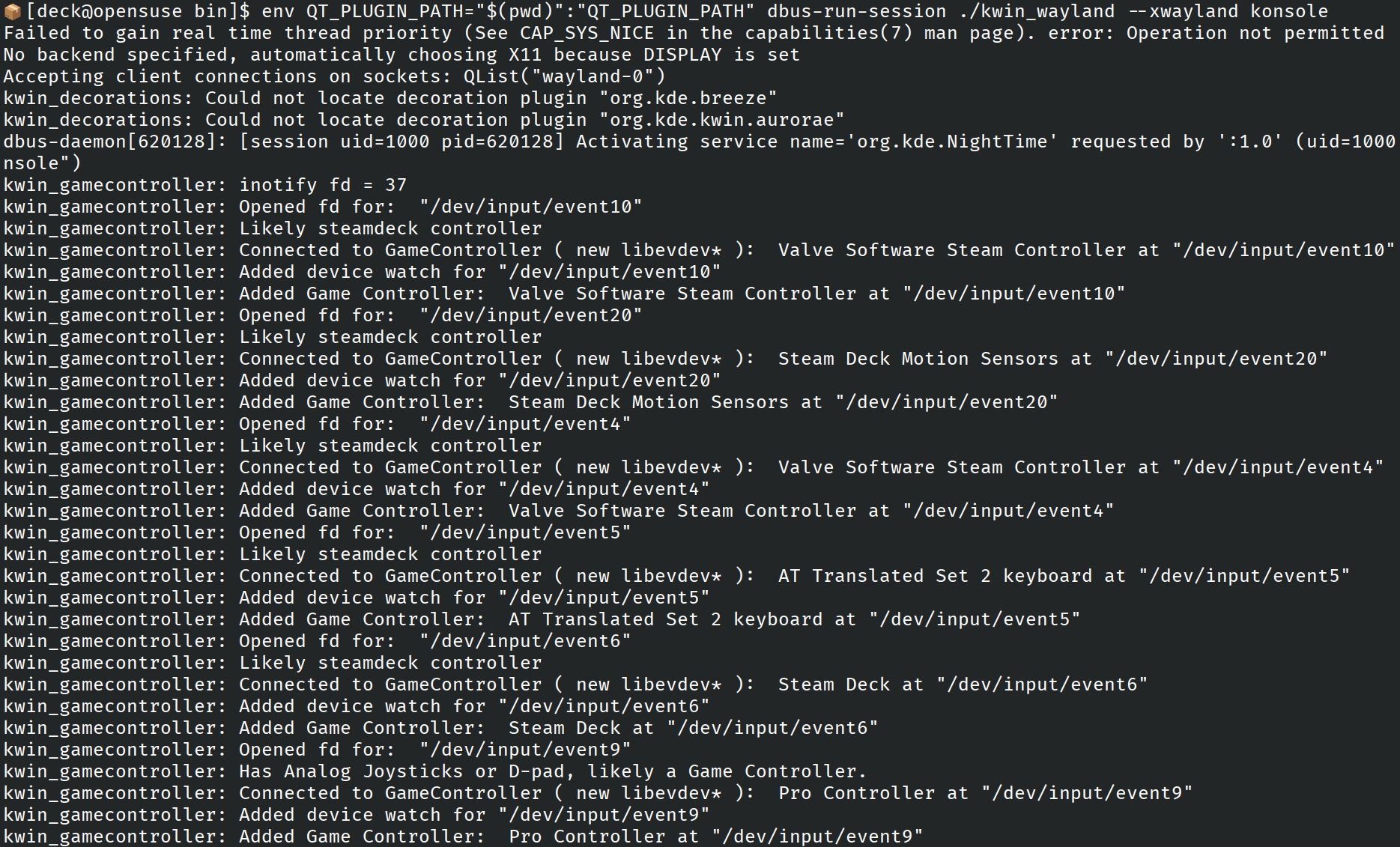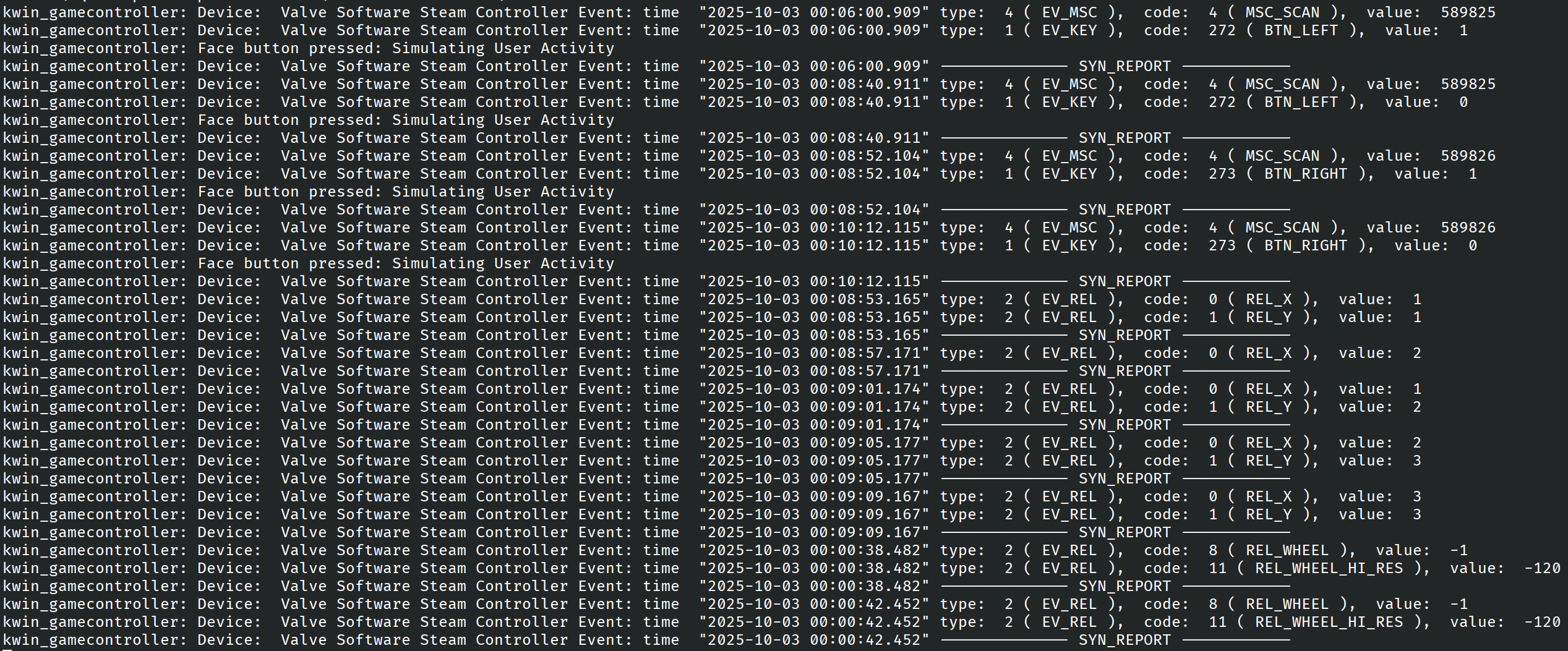GSoC'25 KWin Project Blog Post: Week 5-6
KWin GameController Plugin: Weeks 5-6
It's been another few weeks of progress on the KWin GameController Plugin and I've got a lot to share! After spending the previous weeks setting up the foundation, I've progressed things forward by improving the logic a bit more, creating a few integration tests, integrating it into System Settings, and making sure it runs well on real hardware like the steamdeck.
The primary change was splitting up GameController into two classes. The new one being GenericInputDevice which lives in emulatedInputDevice.{cpp/h}. This allowed me to separate the GameController logic responsible for emulating keyboard and mouse into it's own separate class. Now GameController wrapper class is just responsible for monitoring controller input, resetting idle timer on user activity, and logging.
GenericInputDevice
GenericInputDevice is a class that inherits from InputDevice and is used to emulated Keyboard/Mouse in order to send those inputs through KWins input pipeline. The input_events come from GameController and get processed exactly like they were previously. Each GameController has access to an instance of GenericInputDevice to make its own calls. In the near future I plan on creating a static instance of this class for all GameController to access.
// Inside Gamecontroller construct
m_inputdevice = std::make_unique<EmulatedInputDevice>();
KWin::input()->addInputDevice(m_inputdevice.get());
..
// GameController Event Handling Function
void GameController::handleEvdevEvent()
{
input_event ev;
for (;;) {
const int rc = libevdev_next_event(m_evdev.get(), LIBEVDEV_READ_FLAG_NORMAL, &ev);
if (rc == 0) {
logEvent(&ev);
input()->simulateUserActivity();
if (m_usageCount == 0 || isTestEnvironment)
m_inputdevice->emulateInputDevice(ev);
..
// EmulatedInputDevice
void EmulatedInputDevice::emulateInputDevice(const input_event &ev)
{
m_ev = ev;
if (ev.type == EV_KEY) {
qCDebug(KWIN_GAMECONTROLLER) << "Face button pressed: Simulating User Activity";
evkeyMapping();
} else if (m_ev.type == EV_ABS) {
qCDebug(KWIN_GAMECONTROLLER) << "Analog buttons pressed: Simulating User Activity";
evabsMapping();
}
}
void EmulatedInputDevice::evkeyMapping()
{
bool state = m_ev.value ? true : false;
std::chrono::microseconds time = std::chrono::seconds(m_ev.time.tv_sec) + std::chrono::microseconds(m_ev.time.tv_usec);
switch (m_ev.code) {
case BTN_SOUTH: // A button → Enter
sendKeySequence(QKeySequence(Qt::Key_Return), state, time);
break;
case BTN_EAST: // B button → Escape
sendKeySequence(QKeySequence(Qt::Key_Escape), state, time);
break;
case BTN_NORTH: // X button → Virtual Keyboard
// TO-DO toggle Virtual Keyboard not working on my distro ( Kubuntu )
EmulatedInputDevice::toggleVirtualKeyboard(QStringLiteral("forceActivate"));
case BTN_WEST: // Y button → Space
sendKeySequence(QKeySequence(Qt::Key_Space), state, time);
break;
case BTN_TL: // L button → Ctrl
sendKeySequence(QKeySequence(Qt::Key_Control), state, time);
break;
case BTN_TR: // R button → Alt
sendKeySequence(QKeySequence(Qt::Key_Alt), state, time);
break;
case BTN_START: // START button → Meta
sendKeySequence(QKeySequence(Qt::Key_Meta), state, time);
break;
case BTN_SELECT: // SELECT
break;
// Add more button mappings here as needed
default:
break;
}
}
..
Integration Test: Qt Test
Part of the requirements for proposing significant contributions to KWin is creating integration test. This provides some assurance that things, like core functionality of the plugin, won't break so easily in the future as new code gets added. For testing KWin uses Qt Test Framework. It's been fairly simple and straightforward learning how to use the framework to create my own tests. Still, what exactly to test and how to test it was not so straightforward.
I learned along the way that I'd be creating integration test instead of unit test. The test don't reference the plugins directly, instead they test the effect of the plugins on the system over all. That meant that things which required an instance of the plugin to test were not possible in this case. That included testing hotplug capability or number of applications that plugin thinks has opened an input device. Thankfully there were a few very important functionalities that could be tested! Those include:
// Test system idle time reset. Prevents suspend
void testResetIdleTime();
// Test Controller To Keyboard Input Emulation
void testKeyboardMapping();
// Test Controller To Pointer/Mouse Input Emulation
void testPointerMapping();
I took a lot of inspiration from the buttonrebind_test.cpp.
System Settings KCM
It was agreed upon early on that this plugin would be opt-in, allowing the user to enable and disable it when they choose. For that I created a KDE Control Module or KCM. Or better put, I built on the existing Game Controller KCM :) I added a new UI element, a toggle, for users to enable and disable the plugin. On the backend I added a Q_PROPERTY, pluginEnabled that is responsible for checking the kwinrc Plugin configs and writing to it for managing the state of this plugin. This is what it currently looks like (subject to change):

Handling Lizard Mode
This was probably one of the most daunting parts of the project for me when I first started. I knew that steamOS had its own way of handling input coming from the steamdeck controller which has nothing to do with KDE or Steam app. This is what allows the controller to work for navigating the device in game and desktop mode when Steam app is closed. It's what is refered to as "Lizard Mode". The controller -> keyboard/pointer rebinds that I implemented was based off of the rebinds of this Lizard mode. Ideally using a controller to navigate desktop feels/works the same across all devices on KDE. It's important that this new plugin not disrupt the current input system for the steamdeck. Originally I was warned that opening the fd for this device would cause Lizard mode to be disabled which would mean I would have to either:
A: Find a way to disable Lizard mode and implement it from scratch..
B: Figure out what disabled Lizard mode on FD open and how to prevent / enable it as needed.
or
C: Just change the flag for opening the controller fd and everything works just fine :)
Yup, that easy. After some testing and the smallest change I've had to make all project, the steamdeck controller was able to be detected by the plugin including its input events! Even better than that, and not sure why I did not put this together before, steamdeck already maps its input to keyboard/mouse. Duh. So this gamepad plugin doesn't need to worry about mapping for steamdeck controller, just use its input events to prevent system sleep when activity from that controller is detected.
During my testing I discovered that steamdeck shows up on the system as 5 different controllers. Each having their own purpose, one to handle analog input (triggers, trackpads, sticks) another to handle face buttons & D-pad, another for keyboard, etc.. These are used by the system depending on the users needs. Again, this made life a lot easier. This are logs from evtest and gamecontroller plugin:



At the start of this project I had adopted a child. Some of you reading this post might have met my child. It's named Bug328987. It had been drifting as part of the KDE community for some time looking for someone to take care of it. But that never happened, and thus time just went on, and on. As some put it:
timonoj: Wow this is an ELEVEN (!) year old bug.
WS: This issue is so old it can go to middle school.
and my favorite
Holmes: Is there any hope that this bug will be fixed before the heat death of the universe?
By the time I met Bug328987 it had been around for ~12 years. But still! In the eyes of KDE, it was a young, bright eyed, workflow breaking bug like all the bugs out there and it had potential to be fixed! After months of back and forth with mentors, living in KDE matrix server like it were my personal Discord server, and learning how to not do things in the code base - I'm proud to say gamecontroller plugin properly addresses Bug328987. Bringing to an end its more than a decade long journey. They grow up so fast.
What’s next from here
- Integration into Kwin Proper: "Draft" label has been removed from MR and is ready for review.
- Final Fixes and Touch-up: Get Virtual Keyboard working, KCM toggle hot-plug, improve analog -> pointer emulation.
Reference documentation:
- buttonrebind_test: https://invent.kde.org/plasma/kwin/-/blob/master/autotests/integration/buttonrebind_test.cpp
- GameController KCM: https://invent.kde.org/plasma/plasma-desktop/-/tree/master/kcms/gamecontroller
- Qt Test: https://doc.qt.io/qt-6/qtest-overview.html
- Steam Controller Input: https://www.reddit.com/r/SteamController/wiki/index/
Other useful links: KWin Gamepad Plugin: https://invent.kde.org/yorisoft/kwin/-/tree/work/yorisoft/gamepad-plugin/src/plugins/gamepad